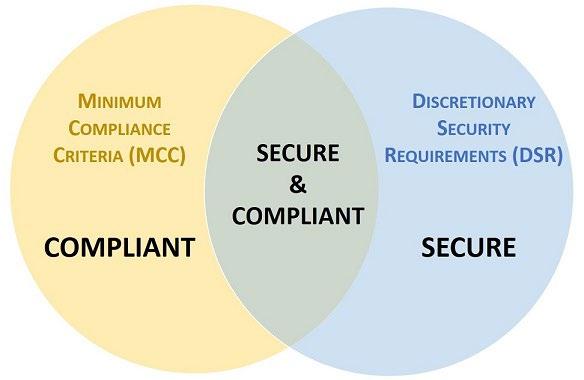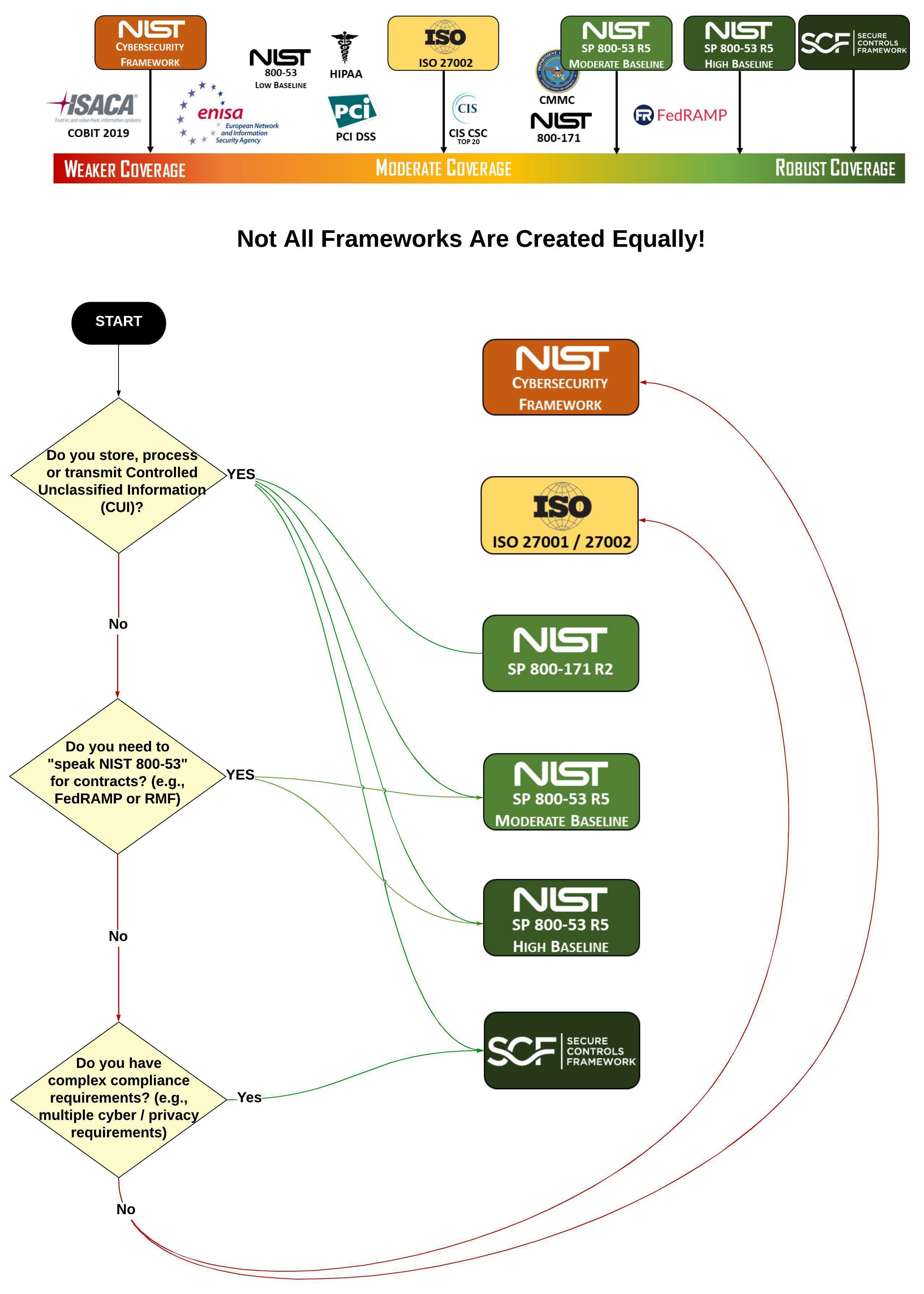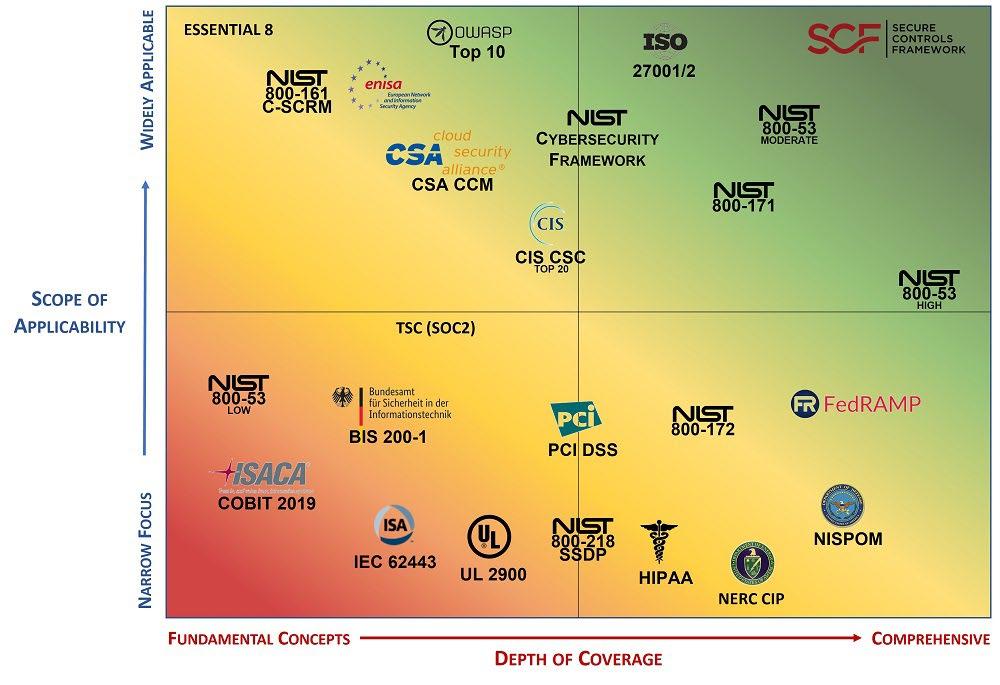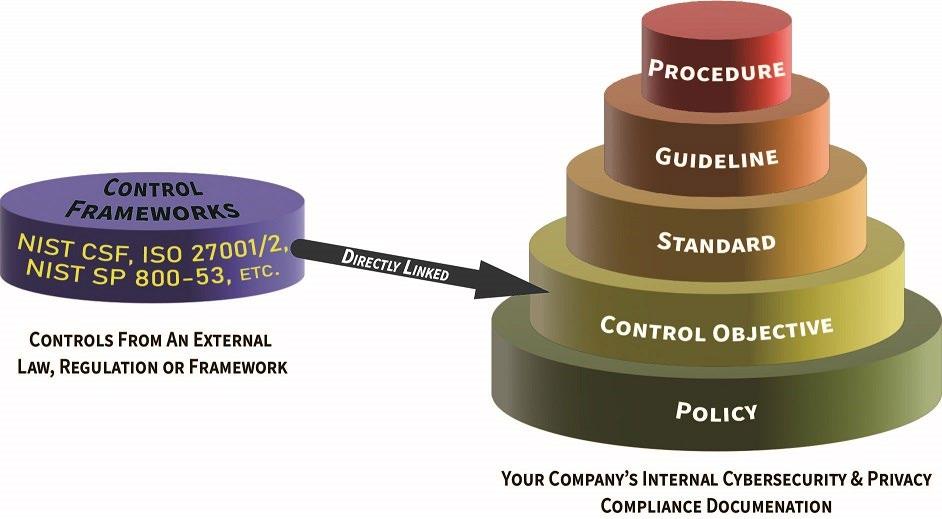





















When you graphically depict the various, leading cybersecurity frameworks from "easier to harder" it primarily focuses on the sheer number of unique cybersecurity and privacy controls. We refer to it as the "cybersecurity Goldilocks dilemma" since organiza�ons struggle with finding a cybersecurity framework that is "not too hard, not too so�, but just right!" for their specific needs. To solve this, it comes down to first defining your "must have" and then "nice to have" requirements, since that helps point you to the most appropriate framework for your specific needs. This guide will help explain those concepts in greater detail.
The concept of a "best" cybersecurity framework is misguided, since the most appropriate framework to align with is en�rely dependent upon your business model. The applicable laws, regula�ons and contractual obliga�ons that your organiza�on must comply with will most o�en point you to one of five (5) star�ng points to kick off the discussion about "Which framework is most appropriate for our needs?”
NIST Cybersecurity Framework (NIST CSF)
ISO 27001/27002
NIST SP 800-171
NIST SP 800-53 (moderate or high baselines)
Secure Controls Framework (SCF) (or a different metaframework)
The number of included controls (e.g., requirements) directly impacts the number of domains covered by a specific cybersecurity framework. The lesser number of controls in a cybersecurity framework might make it appear easier to implement, but it also might not provide the necessary coverage that your organiza�on needs from the perspec�ve of administra�ve, technical and physical cybersecurity and privacy prac�ces.
Defining "just right" for your cybersecurity and privacy controls is primarily a business decision, based on your organiza�on's risk profile, which needs to consider applicable laws, regula�ons and contractual obliga�ons that are required to support exis�ng or planned business processes.


Minimum Security Requirements (MSR) are made up on a combina�on of both mandatory and discre�onary requirements. This can be considered a combina�on of you “must have” and “nice to have” requirements:
Minimum Compliance Criteria (MCC) are “must have requirements” that are defined by applicable laws, regula�ons and contractual obliga�ons that your organiza�on must comply with.
Discre�onary Security Requirements (DSR) are “nice to have requirements” that are not legally-required but you feel you require to be secure, such as FIM, DLP, MFA, etc.
Those two considera�ons come together to address the "Compliant vs Secure" balancing act that determines if an organiza�on's cybersecurity and/or privacy program will be both secure and compliant, or just compliant (e.g., focus on the bare minimums):
Lesser mature organiza�ons tend to focus on compliance over security.
More mature organiza�ons tend to focus on making compliance a natural byproduct of being secure.

This concept is further explained in the Integrated Controls Management (ICM) framework:
MCC are primarily externally-influenced, based on industry, government, state and local regula�ons. MCC should never imply adequacy for secure prac�ces and data protec�on, since they are merely compliance-related.
DSR are primarily internally-influenced, based on the organiza�on’s respec�ve industry and risk tolerance. While MCC establish the founda�onal floor that must be adhered to, DSR are where organiza�ons o�en achieve improved efficiency, automa�on and enhanced security.
There are a few ques�ons that can help quickly narrow down appropriate and inappropriate frameworks for your needs:
1. Do you store, process or transmit Controlled Unclassified Informa�on (CUI)?
a. If yes, look at NIST SP 800-171, NIST SP 800-53 or Secure Controls Framework (SCF).
b. If no, proceed to ques�on 2.
2. Do you need to “speak NIST 800-53” for a contract? (e.g., FedRAMP or RMF)
a. If yes, look at NIST SP 800-53 (moderate or high baseline)
b. If no, proceed to ques�on 3.
3. Do you have complex compliance requirements? (e.g., mul�ple cybersecurity / privacy requirements)
a. If yes, look at Secure Controls Framework (SCF).
b. If no, look at NIST Cybersecurity Framework (CSF) or ISO 27001 / 27002
See the graphic on the next page to visualize this decision process.


Have a discussion with your legal and procurement departments to find out what laws, regula�ons and contractual obliga�ons your organiza�on needs to comply with. If they don't know, then you need to perform that discovery with their involvement to ensure you have the facts. Do not try to work off assump�ons!
Talk with peers in your industry to iden�fy what framework(s) their organiza�on chose to align with and what those decisions were that led them to adop�ng one framework over another. You s�ll have to do your own analysis to determine what is right, but talking with peers can help avoid "re-inven�ng the wheel" on certain aspects of the analysis process.
Determine what resources you have available to adopt and implement a framework. If it is a flip of the coin decision between two frameworks where you feel both meet your needs, you need to be sure to take into account which framework will be the most efficient to implement and maintain.
Evaluate your organiza�on's business and IT strategies to iden�fy components that may require the adop�on of a specific framework. For example:.
o Your CEO puts out a roadmap to grow business and next year the company will start going a�er US Government and Department of Defense (DoD) contracts. This means your organiza�on will have to address DFARS, FAR and CMMC compliance, which is based on NIST SP 800-171. This means alignment with NIST SP 800-53 or SCF might be the best path forward.
o A business unit is expanding into the European market and will focus on B2C sales. This means your organiza�on will have to address EU GDPR for robust privacy prac�ces, on top of cybersecurity. This means you could select any framework to address underlying cybersecurity prac�ces, but you need a privacy program. The SCF might be the best path forward.
Speak with a reputable consultant. Not all "cybersecurity professionals" have the same backgrounds, experiences and competencies. Speak with a Governance, Risk and Compliance (GRC) professional about compliance-related frameworks and scoping decisions.

To help provide further context to the image:
ISO 27001/2 is essen�ally a subset of the content found in NIST 800-53 (ISO 27002 went from fourteen (14) sec�ons in 2013 to three (3) sec�ons in 2022) where ISO 27002's cybersecurity controls fit within the twenty (20) families of NIST 800-53 rev5 security controls.
NIST CSF is a subset of NIST 800-53 and also shares controls found in ISO 27001/2
NIST CSF incorporates parts of ISO 27001/2 and parts of NIST 800-53, but is not inclusive of both - this is what makes NIST CSF is a common choice for smaller companies that need a set of "industry-recognized secure prac�ces" to align with, where ISO 27001/2 and NIST 800-53 are beter for larger companies or those that have unique compliance requirements.

If you look at this from the perspec�ve of a debate over which so� drink tastes best (e.g., Coke vs Pepsi), it generally comes down to personal preferences, since both products are essen�ally sugary, carbonated drinks and only differ slightly in flavor and packaging. The same arguments can be made for cybersecurity’s two heavy hiters – NIST 800-53 and ISO 27002. Gaining popularity is the NIST Cybersecurity Framework (NIST CSF), but it lacks appropriate coverage out of the box to be considered a comprehensive cybersecurity framework. For more complex compliance requirements, the SCF is a "metaframework" that encompasses over 100 laws, regula�ons and frameworks in a hybrid framework that can span mul�ple compliance requirements.
It is not uncommon for experienced cybersecurity practitioners to have fundamental misunderstandings of the differences between laws, regulations and frameworks. However, in this context, what is depicted on the heatmap is referred to as a "framework" since by the NIST Glossary definition, a framework is "a layered structure indicating what kind of programs can or should be built and how they would interrelate." Even a law or regulation can serve as a framework for building a cybersecurity program.

We understand that it can be a little confusing when you look at it from a "heat map" perspective, since each cybersecurity framework has its own unique scope of applicability (e.g., specialization) and depth of coverage. However, understanding this can help you make an informed decision on where to start for the most appropriate framework(s) for your needs (often, organizations utilize more than one framework). You may even find you need to leverage a metaframework (e.g., framework of frameworks) to address more complex compliance requirements.

If you are not familiar with the Secure Controls Framework (SCF), it was developed with the ambi�ous goal of providing a comprehensive catalog of cybersecurity and privacy control guidance to cover the strategic, opera�onal and tac�cal needs of organiza�ons, regardless of its size, industry or country of origin. By using the SCF, your IT, cybersecurity, legal and project teams can speak the same language about controls and requirement expecta�ons! The SCF is a "metaframework" which is a framework of frameworks. The SCF is a superset that covers the controls found in NIST CSF, ISO 27002, NIST 800-53 and over 100 other laws, regula�ons and frameworks. These leading cybersecurity frameworks tend to cover the same fundamental building blocks of a cybersecurity program, but differ in some content and layout. Before picking a framework, it is important to understand that each one has its benefits and drawbacks. Therefore, your choice should be driven by the type of industry your business is in and what laws, regula�ons and contractual obliga�ons your organiza�on needs to comply with.
The SCF is an open source project that provides free cybersecurity and privacy controls for businesses. The SCF focuses on internal controls, which are the cybersecurity and privacy-related policies, standards, procedures and other processes that are designed to provide reasonable assurance that business objec�ves will be achieved and undesired events will be prevented, detected and corrected.
The Secure Controls Framework (SCF) is a "best in class" approach that covers over 100 cybersecurity and privacy laws, regula�ons and frameworks, including NIST 800-53, ISO 27001/2 and NIST CSF. Being a hybrid, it allows you to address mul�ple cybersecurity and privacy frameworks simultaneously. The SCF is a free resource for businesses to use. ComplianceForge's Digital Security Program (DSP) has 1-1 mapping with the SCF, so the DSP provides the most comprehensive coverage of any ComplianceForge product.
The Secure Controls Framework (SCF) is commonly use by medium to large businesses, but can be used by any business with complex cybersecurity and privacy requirements.
The SCF can be used for:
Any sized business
Any industry
The SCF should not be used for:
Simple compliance needs
The Na�onal Ins�tute of Standards and Technology (NIST) is on the fi�h revision (rev5) of Special Publica�on (SP) 800-53, Security and Privacy Controls for Informa�on Systems and Organiza�ons. From rev4 to rev5, NIST dropped the "US Government" focus for NIST SP 800-53 and now has it generalized enough for private industry to use. There are s�ll "NISTisms" for wording that are en�rely US Government-focused, but it is a significant improvement for private industry adop�on. NIST 800-53 "best prac�ces" are the de facto standard for private businesses that do business with the US federal government.
One thing to keep in mind is that NIST 800-53 is a super-set of ISO 27002 - that means you will find all the components of ISO 27002 covered by NIST 800-53. However, ISO 27002 does not cover all of the areas of NIST 800-53.
The Federal Informa�on Security Management Act (FISMA) and the Department of Defense Informa�on Assurance Risk Management Framework (RMF) rely on the NIST 800-53 framework, so vendors to the US federal government must meet those same requirements in order to pass these rigorous cer�fica�on programs. Addi�onally, for NIST 800-171, Protec�ng Controlled Unclassified Informa�on in Nonfederal Informa�on Systems and Organiza�ons, NIST 800-53 is called out as the best prac�ces for government contractors to secure their systems. That further helps strengthen NIST 800-53 as a best prac�ce within the US, especially for any government contractors. We have a sec�on that describes NIST 800-171 and Cybersecurity Maturity Model Cer�fica�on (CMMC) if you are interested in that subject.

NIST 800-53 includes what both ISO 27002 and NIST CSF addresses, as well as a whole host of other requirements. NIST 80053 is the basis for the controls found in NIST 800-171 / CMMC. NIST 800-53 is commonly found in the financial, medical and government contrac�ng industries. One great thing about NIST 800-53, and it applies almost universally to all NIST 800-series publica�ons. As with other NIST publica�ons, it is freely available, at no cost to the public: htp://csrc.nist.gov/publica�ons/PubsSPs.html.
NIST 800-53 Moderate is commonly used by medium to large businesses and is primarily US-focused.
NIST 800-53 Moderate can be used for:
Defense Contractors (CMMC, RMF, etc.)
Government Contractors (FedRAMP, RMF, etc.)
Technology Businesses (e.g., MSPs, CSPs, etc.)
General Business (large)
Retail (large)
Healthcare (large)
Insurance (large)
NIST 800-53 Moderate should not be used for:
Smaller Businesses
NIST 800-53 High is commonly use by medium to large businesses with an explicit requirement for the high baseline and is primarily US-focused.
NIST 800-53 High can be used for:
Defense Contractors (large)
Government Contractors (large)
Technology Businesses (large)
NIST 800-53 High should not be used for:
Smaller Businesses
The Na�onal Ins�tute of Standards and Technology (NIST) is on the second revision (rev2) of Special Publica�on (SP) 800-171, Protec�ng Controlled Unclassified Informa�on in Nonfederal Systems and Organiza�ons. The US Na�onal Archives (NARA) runs the Controlled Unclassified Informa�on (CUI) Program for the US Government and NARA specifies NIST SP 800-171 and 800-171A as the minimum requirements to protect CUI. NIST SP 800-171 is the basis for the controls used by the US Department of Defense's Cybersecurity Maturity Model Cer�fica�on (CMMC). As with other NIST publica�ons, it is freely available, at no cost to the public - htp://csrc.nist.gov/publica�ons/PubsSPs.html.
NIST 800-171 can be used by any sized organiza�on, since it is the required set of controls necessary to protect CUI where it is stored, processed and/or transmited.
NIST 800-171 can be used for:
Defense Contractors
Government Contractors
Technology Businesses (MSPs, MSSPs, etc.)
NIST 800-171 should not be used for:
FedRAMP or RMF compliance

The Interna�onal Organiza�on for Standardiza�on (ISO) is a non-governmental organiza�on that is headquartered in Switzerland. ISO can be a litle more confusing for newcomers to IT security or compliance, since a rebranding occurred in 2007 to keep ISO’s IT security documents in the 27000 series of their documenta�on catalog - ISO 17799 was renamed and became ISO 27002. To add to any possible confusion, ISO 27002 is a suppor�ng document that aides in the implementa�on of ISO 27001. Adding a litle more confusion to the mix, it is important to note that companies cannot cer�fy against ISO 27002, just ISO 27001.
ISO 27001 Appendix A contains the basic overview of the security controls needed to build an Informa�on Security Management System (ISMS), but ISO 27002 provides those specific controls that are necessary to actually implement ISO 27001. Essen�ally, you can't meet ISO 27001 without implemen�ng ISO 27002:
ISO/IEC 27001:2022 - Informa�on security, cybersecurity and privacy protec�on — Informa�on security management systems — Requirements
ISO/IEC 27002:2022 - Informa�on security, cybersecurity and privacy protec�on — Informa�on security controls
To keep things simple, just remember that ISO 27001 lays out the framework to create an “Informa�on Security Management System (ISMS)” (e.g., a comprehensive IT security program), whereas ISO 27002 contains the actual “best prac�ces” details of what goes into building a comprehensive IT security program. Since ISO’s informa�on security framework has been around since the mid-1990s, it was in “right �me at the right place” to evolve into the de facto IT security framework outside of the United States. You will find ISO 27002 extensively used by mul�na�onal corpora�ons and for companies that do not have to specifically comply with US federal regula�ons. ISO 27002 is also “less paranoid” than NIST 800-53, which has an advantage of being less complex and therefore easier implement.
One unfortunate thing about ISO 27001/2, and it applies to all ISO publica�ons, is that ISO charges for its publica�onshtps://www.iso.org/isoiec-27001-informa�on-security.html
ISO 27001 / 27002 is commonly use by medium to large businesses and is interna�onally-recognized (e.g., ISO 27001 cer�fica�on).
ISO 27001 / 27002 can be used for:
General Business
Retail
Healthcare
Insurance
ISO 27001 / 27002 should not be used for:
Defense Contractors
Government Contractors
NIST Cybersecurity Framework (NIST CSF) has the least coverage of the major cybersecurity frameworks. NIST CSF works great for smaller and unregulated businesses that just want to align with a recognized cybersecurity framework. The downside to the NIST CSF is that its brevity makes it incompa�ble with common compliance requirements, such as NIST 800-171, GDPR, CPRA/CCPA and PCI DSS (depending on SAQ level). For those, more comprehensive frameworks, such as NIST 800-53 or ISO 27002 are recommended.
In reality, NIST CSF is a "dumbed down" and civilianized version of NIST 800-53. It came out nearly a decade ago when NIST 800-53 was en�rely focused on the US Government, so there was a need for a subset of the controls that NIST 800-53 provided but for the non-enterprise space in private industry (e.g., tailored for small to medium businesses). Over the past decade, different US Federal agencies have published documents describing how NIST CSF v1.1 controls can be leveraged to comply with HIPAA, FINRA, etc.

Overall, NIST CSF does not introduce new standards or concepts, but leverages and integrates industry-leading cybersecurity prac�ces that have been developed by organiza�ons like NIST and ISO. NIST CSF if organized into five categories of controls:
1. Iden�fy
2. Protect
3. Detect
4. Respond
5. Recover
The NIST CSF comprises a risk-based compila�on of guidelines that can help organiza�ons iden�fy, implement, and improve cybersecurity prac�ces, and creates a common language for internal and external communica�on of cybersecurity issues. The NIST CSF is designed to evolve with changes in cybersecurity threats, processes, and technologies. Essen�ally, the NIST CSF envisions effec�ve cybersecurity as a dynamic, con�nuous loop of response to both threats and solu�ons. However, the "framework implementa�on �ers" should be avoided, since it is bad guidance. For example, you have to get to Tier 3 before you document policies, standards or procedures. That means a business at Tier 1 and Tier 2 would be considered negligent for failing to meet "reasonable expecta�ons" for a security program. This is an example of "the path to hell is paved with good inten�ons" so that component of NIST CSF should be avoided.
NIST CSF is commonly use by smaller businesses and unregulated industries.
NIST CSF can be used for:
General Business
Retail
Healthcare (small)
Insurance
Educa�on
NIST CSF should not be used for:
Defense Contractors
